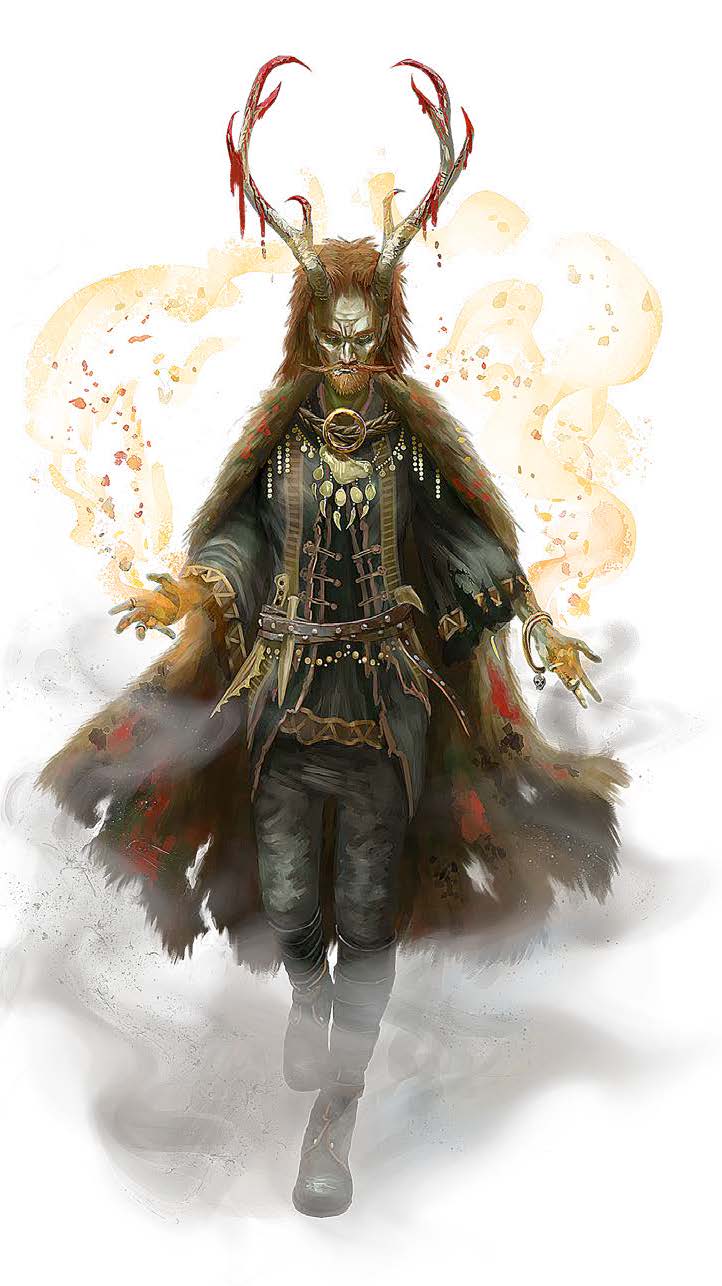
The Midgard Worldbook already details a score of saints dedicated to the war god Mavros, but the other deities have their share of saints as well. Saints of Midgard uncovers some of these holy personages, including information on their origins, followers, blessings and miracles, and the relics attributed to them.
Saint Uborkagg
Origins. Born in the depths of a vast cave system in the Ironcrags, Uborkagg was a sickly ogre who almost perished at the hands of his own mother. Reviled for his weakness, the rest of his family used Uborkagg as a whipping boy and plaything. Yet despite the torment inflicted upon him, he persisted, making up for his lack of physical strength with an almost feral cunning.
After one particularly heinous beating, Uborkagg engineered the deaths of the rest of his family by leading them into a dwarven ambush, watching on with delight as they were peppered with crossbow bolts and blown away with magical flame. This act drew the attention of one of Chernobog’s demonic servants, a foul rubezahl demon (see Tome of Beasts) named Voglsaz, who approached Uborkagg with an offer to transform him into a one-horned ogre (see Tome of Beasts 2) in exchange for serving the god of darkness. Uborkagg instantly agreed and, with his new magical power, size, and strength, set about making a name for himself.
Over the next few years, Uborkagg became a cleric of Chernobog, devouring or sacrificing any dwarf or human unwary enough to fall into his clutches and spreading the god’s words of misery and hatred to every giant he could find, his Charisma swaying even the most belligerent of frost giants.
After years of causing mayhem throughout the Ironcrags, the dwarves of Hammerfell eventually had enough and sent a company into the wilds to slay the monstrous creature. They tracked Uborkagg through the peaks for weeks, braving many dangers before finally cornering him in a steep canyon deep in the Eastern Ironcrags. Yet while they managed to kill Uborkagg, the one-horned ogre’s revenge was swift and lethal, weakening the surrounding cliffs with magic and bringing them down on his pursuers, crushing scores beneath a landslide that could be felt and heard for many miles.
After his death, Uborkagg continues to haunt the Ironcrags as a demonic spirit in the service of Chernobog, appearing as a ghostly version of himself, his great white horn awash with flickering violet flame.
Followers. While Uborkagg would have probably passed forgotten into the annals of history, his last act left a lasting impression on the people of the surrounding lands, and any mention of the ogre in the Ironcrags normally results in disapproving stares and curses. Commonly known as the Patron Saint of Landslides, Uborkagg is served by many lesser demons, ogres, and depraved humans, all who venerate the fallen ogre and the Black God he serves.
Perhaps the most well-known of Uborkagg’s followers are the cliff-runner ogres. These swift, lean giants are adept at using hooked ropes to scale cliffs and descend into ravines. They also use the rope hooks as weapons, snagging and pulling creatures off ledges or out of the air. Though rare, cliff-runner ogres are a headache for many travelers passing through the hills and mountains of Midgard.
Blessings and Miracles. Uborkagg’s blessings are rare and often do more harm than good. Sudden cave-ins and landslides to bury one’s enemies are signs of his favor but often result in death or injury to the follower as well.
No miracles have ever been attributed to Uborkagg directly, and technically, Chernobog’s priests have never officially recognized the one-horned ogre’s sainthood.
Holy Relics
The relics of the saints are items of renown and power, vitally important to those of the same faith and zealously sought after and guarded.
HORN OF SAINT UBORKAGG
Rod, very rare (requires attunement)
Pulled from Uborkagg’s skull shortly after his death, this 3-foot-long horn has the appearance of bleached bone, its spiked end wrapped in tattered leather strands. The current owner of the horn is a vile and wily goblin named Blargnat who serves the Gutchewer Tribe of the Black Hills as their shaman.
The horn functions as a rod. It possesses the following properties. Both properties of the rod recharge at dawn.
Collapse. You cause a section of wall or cliff within 60 feet of you to collapse. Any creature caught under the falling rocks must succeed on a DC 15 Dexterity saving throw or take 8d6 bludgeoning damage and become buried under the rubble. A buried creature is considered restrained and takes an additional 2d6 bludgeoning damage at the end of its turn so long as it remains buried. A buried creature can free itself with a DC 20 Strength (Athletics) check. A creature that makes its saving throw takes half damage and isn’t buried. You can use this property once per day.
Horn Blast. You target a creature within 30 feet. The creature must make a DC 15 Wisdom saving throw, taking 3d6 psychic damage on a failed save or half as much damage on a successful one. A creature that fails the saving throw is also frightened until the end of its next turn. This property recharges after a short or long rest.

Yes! More Chernoboggians, please!